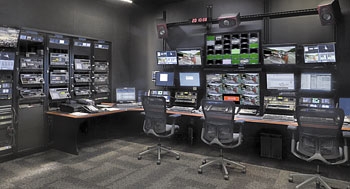SPEED Heeds Need for HD

SPEED network's new facility includes a 3,600 square foot studio designed for HD.CHARLOTTE, N.C.
Whether racing fans readily admit it or not, those crashes look astonishing on TV. And even more so in HD.
When the Fox SPEED network catches the action on screen—the crushed metal of a busted NASCAR bumper whipping across the track, or flecks of the rubber tire as it flies into the stands—there's no better way to see it than in glorious high-definition.
Bringing fans the excitement of high-speed racing is a job that the Charlotte, N.C.-based SPEED network takes seriously. Last summer the network began scoping out a location for a new home, and is in the midst of building out a new 77,000-square-foot HD facility.
With the help of parent Fox Cable Network's Network Engineering and Operations division, SPEED worked with outside systems integrators Diversified Systems and National TeleConsultants to design a facility that offers key technological enhancements: quick ingest, rapid editing capability and the ability to almost simultaneously repurpose content for alternative distribution channels—and do it in a tapeless environment to boot.
FILE-BASED

SPEED network's coverage of auto and moto racing is available in over 78 million homes in North America. The new file-based HD facility—where SPEED covers live events like NASCAR, Formula 1 and moto racing—is built around two dedicated studios, including a 3,600-square-foot stage; a 2,400-square-foot space; and a smaller insert studio to produce in-house news programming.
And one key component of the new facility is its file-based approach to content acquisition, editing and production.
"We wanted to take a best-of-breed approach" when building this facility, said Rick Miner, senior vice president for production and network operations for SPEED. That includes turning to a file-based setup that allows the network to facilitate HD workflow through streamlined video content management solutions. The result is one of the few end-to-end file-based installations producing HD programs using a variety of broadcast and third party IT systems, Miner said. The network manages HD content and production workflows with Dalet Digital Media Systems' Enterprise Edition management system.
"We wanted a flexible and open technology infrastructure [that] would enable us to integrate multiple systems in our production workflow as well as adapt to new distribution methods easily," Miner said.
By building an infrastructure based on open solutions and IT-based technology, staffers are more easily able to identify material, track metadata, search for content and facilitate editing as content moves through the facility.
Rather than rely on products from one manufacturer, the network cherry-picked equipment from the top down, turning to Ikegami for studio cameras, Sony and Ross for switchers, Calrec for audio, Omneon for servers, and Panasonic for format ingest, among others.

SPEED network hired SIs Diversified Systems and National Teleconsultants to design the new facility. To start, all original HD material is shot in native 720p DVCPRO HD with 5.1 audio; material that arrives in a standard-definition format or in 1080i is converted.
Perhaps surprisingly, the very next step in the production chain is editing. "On ingest, we create a high- and low-res proxy simultaneously," Miner said. "You're able to edit 30 seconds after ingest." Via 125 separate desktop clients, staffers can begin program pre-production. "We wanted them to be able to view low-resolution files in the servers and scale, log or drop-in edits as needed," he said.
These rough-cut packages are sent to editors to manipulate and finalize at any of 12 Apple Final Cut Pro stations. Storage is handled via DataDirect Networks SAN storage and Quantum StoreNext SAN file system via Omneon servers. Front Porch DIVArchive software helps enable content archiving and partial restore capabilities. "We needed to be able to do partial restores of archived material," Miner said.
The expansive search-and-find capabilities of the network's file-based architecture means that editors can now search for and pull up a miniscule piece of a program they hope to air, rather than the entire media segment. "We aren't forced to bring back the whole race," Miner said.
ALTERNATIVE MEDIA
As interest in high-speed auto and motorcycle racing has grown, the network has watched its reach grow; the channel is now available in more than 78 million homes in North America. This boom has pushed the network into interactive TV, video on demand, mobile initiatives and broadband service ventures, too.
All this has encouraged the network to put renewed emphasis on repurposing material for alternative channels. Editing of content for new media outlets is "all done in the same editing system," Miner said, with audio sweetening, content rewrapping, playback and encoding handled in the same production workflow.
The professional video industry's #1 source for news, trends and product and tech information. Sign up below.
Susan Ashworth is the former editor of TV Technology. In addition to her work covering the broadcast television industry, she has served as editor of two housing finance magazines and written about topics as varied as education, radio, chess, music and sports. Outside of her life as a writer, she recently served as president of a local nonprofit organization supporting girls in baseball.

